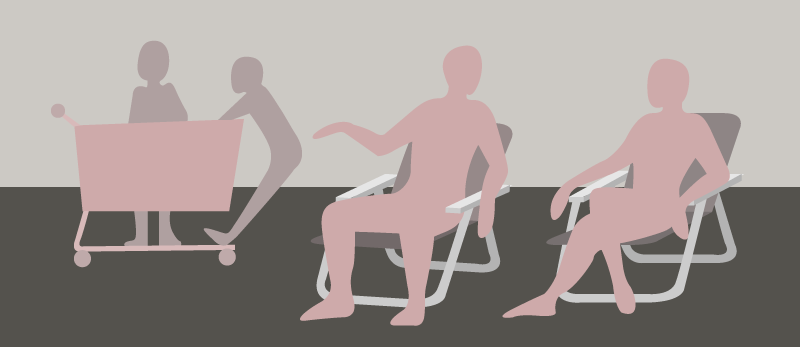Undoubtedly, the skills you learn as a child never leave you. When I quit my day job to focus on writing, my biggest concern was how I was going to pay my bills. My boyfriend and I had just moved into two rooms in a large house in D.C. and were sharing living expenses. Nevertheless, by the end of our first month as new renters, we were already coming up short. Desperate to find the last $100 he needed to meet our $800 rent, my boyfriend decided to go online and try to sell his winter coat. It sold immediately . . . for $100. We made the rent.
Seeing the potential of online vending, we immediately began selling anything we could get our hands on. I saw an escape route from the daily grind of going to a job of inputting data and I took it. Online vending became my “new hustle.” We opened an online store selling gently used clothing. Immediately, I had become an entrepreneur. Since then, my goal each month has been to sell enough clothing online to pay my bills and therefore afford myself the time to write. My new hustle, however, was not really all that new to me. In fact, when I thought about it, I realized that it was actually the culmination of the person I had started to become between the ages of nine and ten.
From the age of four, my Caribbean mom, whose main focus was getting a good education for her children, applied and managed to land me a spot in the number one private school in Washington, D.C. The tuition there was equal to the average person’s yearly income. As a single mom, she struggled to pay it, and, by the time my younger brother enrolled at an equally elite D.C. all-boys school, she was spending more money on private school tuition than most people pay for a year at Harvard. With almost no additional spending money, my mom still managed to deck me out in the most upscale clothes in the entire school. In third grade, I was a private school student who cried when my mother took us shopping to the thrift store. I wanted clothes with tags, new things like my friends had. Instead, she collected gently used Lacoste polos and corduroy pants originally from the Gap. Her aim was to make us look like preppy, upper-class kids, even if we didn’t have the money of those preppy, upper-class kids. Ironically, we looked the part even more than our classmates who were really rich. Think rich like Chelsea Clinton or the Obama girls. (That should give you an indication of which school I attended.) When I insisted that it was okay to wear jeans to school, even ones with holes in them, because all of my friends did, my mother reminded me, “You are not your friends.”
It was a lesson that would be hammered home time and time again in many different ways. In fourth grade, I left my elite private school so that I could spend half of my day training at the ice rink. I had a goal of becoming a champion figure skater along the lines of a Kristi Yamaguchi. There was no way my mom could pay for both the private school tuition and the figure skating lessons, so she enrolled me in a local public elementary school for that year. This was the first time I had ever been in a classroom where there were more black and Hispanic kids than white kids. In fact, I think there may have been only one white student in my class.
Initially, I was terrified and lonely. It seemed everyone knew each other and had found their group. For the first week, I walked around in a daze. No doubt about it: academically, I was at least three grade levels above everyone else in my class — a private school education will do that for you — but socially, I didn’t fit in. By the end of the first week, I noticed one girl in my class, a Salvadorian, was always being sought after at recess by the other students from all the grades. She was running a business. She was selling loose penny candy to everyone and making a chunk of change. Besides the large income she was generating, she was doing something that was even more important to me at the time. She was making friends — tons of them. She was popular because of her candy business. I was totally envious.
That evening, on my ride to my skating lesson, I told my mom about this young business executive who was sought after by everyone. My mom obviously heard the envy in my voice and said “You can do that too. All you have to do is go to the wholesale stores, get some candy and sandwich bags and package them.” I could hardly wait ’til practice was over. My mom drove me to the wholesalers and we purchased sandwich bags and five huge bags of assorted candies. I had everything: M&Ms, miniature Hershey bars, Smarties, gum. You name it, I had it. When I got home, I bagged about 100 bags and put them in my book bag. The next day, I was ready for business.
When the kids saw my stock, it was a wrap. Instantly, I sold out. I made more money than I could shove into my pockets. I had already covered the cost of my purchase at least four times over, and I still had tons of candy for the next week. Above all, I made friends. Everyone liked me, even the teachers. I figured out how to fit in.
I had become a young entrepreneur, selling candy and other treats out of my cubby at Brightwood Elementary School. Though I returned to my private school the following year, now completely on scholarship, whatever had moved me to become a hustler never left. Business at my private school was even better than at Brightwood ’cause my private school classmates were “rich” — they always had money. And since we weren’t allowed to leave the school grounds to buy anything, I had a monopoly. Each day, I would come home and stuff a huge ten-gallon pickle jar with all the money I had made — and it was a lot.
It was obvious that my entrepreneurial skills had never left me, and when it became necessary for me to make rent money, my old skills kicked in. The combination of my sales skills and my knowledge of the quality of goods in the thrift stores where my mom would take us to shop shifted into high gear. I started to make the rounds to all the thrifts in D.C. However, the Goodwill Outlet, or “the Bins” as regular pickers call it, became one of my favorite places to find merchandise — the reason being you shopped by the pound. You were able to fill up a trash bag with items, have it weighed, and pay a dollar a pound. For $30, you could get clothing that would sell for more than $1500.
Shopping at the Goodwill Outlet is essentially the last step before becoming a full-on dumpster diver. At the best of the Outlets, large blue bins are brought out more or less hourly and patrons have the freedom to pick through vintage and modern clothing that has overstayed its welcome at the standard Goodwill stores. There are no racks or dressing rooms. Though you can find clothes, housewares, or accessories there, these things are not organized in any particular way. Shopping is done in rounds, with everyone having to leave the floor and stand behind a line when new merchandise is brought out. Some people stay for hours; some people can only bear it for 20 minutes. Either way, when you’re ready to pay, your clothing is weighed and a dollar amount is determined based on how many pounds you have. Whatever doesn’t sell at the Bins will be sent to the landfill.
Though I’m from D.C., being a non-driver, it is easiest for me to jump on a Megabus and take a quick bus ride out to the Bins in Queens, New York. I got off the four hour Megabus ride, jumped on the MTA train and was sliding between the large blue bins within an hour of my arrival in New York. I shifted stained bedsheets and men’s trench coats out of the way to discover a pink Lacoste cardigan. The woman beside me mumbled “lo siento” as she pushed past to indiscriminately grab a heap full of junk. She moved on down the line of bins until her cart was full, and then I watched her retreat to the sidelines and begin to pick through it. It was a strategy I had noticed several women use. Whether they had always shopped there together or had become friends over time, I didn’t know, but they looked after each other’s children and carts full of junk like family. They spoke in Spanish and came equipped with their own shopping bags and lawn chairs to rest during breaks.
Based on the way they shopped, I assumed they were at the Bins for business, not pleasure. Having parents from the Caribbean provided me some insight. I knew that they sent this clothing back to their countries in barrels, perhaps for a cousin or business associate to sell. These were American clothes after all, presumably the best of the best, as most things from America are assumed to be. It is a hustle you’ll see in any thrift store: Latina, Caribbean, or West African women or men with multiple carts filled with junk most Americans wouldn’t look twice at.
The manager, a pale, heavyset guy named Sal, began to make an announcement. As he yelled through cracked lips, I tried to make my way to the back of the line. An older Asian woman milled around Sal’s side, appraising the crowd. She had a short, blunt haircut and thick glasses. She didn’t work there; I knew because of the shopping bag on her shoulder. Still, her hands were planted on her hips, and she scowled with the authority of a security guard protecting an A-list celebrity.
Some of the Latina women had begun lining up again. Others were still shopping or sitting in their lawn chairs around the perimeter of the store. Trying to maneuver around the crowd, I pushed my cart over a wadded-up sweatshirt. One of the women got up from her lawn chair, brows furrowed, eyes glaring directly at me, and kicked the sweatshirt back into position. I had moved her placeholder.
At the back of the line, I began to pay attention to what Sal was saying. He had just declared that all of the people who were regularly at the front would have to move to the back. I had seen enough to know that he was referring to the Latina women. Apparently, during the last round, the crowd had broken out in a run when Sal said “shop,” instead of walking over to the bins. As the women yelled at him in Spanish, he tried to explain that the running was a safety hazard. He told them that his boss, a mysterious man named Carlos, had seen it all on camera and told him to enforce the rule; that the regulars would have to go to the back. I watched Sal punch his finger desperately at the camera on the wall as he tried to simultaneously lay down the law and pretend to have nothing to do with it. I tried to imagine Carlos: a heavyset man in a dark suit, a cigar hanging halfway out of his mouth, his thick fingers crossed in front of him as he watched us peons scramble for trash on a large flat screen.
Some of the women began pulling their carts over to the bins and throwing junk out. “We spend money, we spend money!” a few of them were yelling. Sal licked his lips and shrugged. “If you wanna leave, leave. I can’t make you stay.” As often happens in these situations — fueled by frustration, progress hindered by a language barrier — a spokesperson emerged. She was the youngest woman in the group, no older than 25, but she took on the anger of her posse with persistence. She had power because she spoke English. Although broken, it was still understandable.
A black beanie was pulled over her head and a few wisps of cropped, black hair poked out underneath. The bags under her eyes were almost as heavy as the bags of junk held by the women surrounding her. She crossed her arms firmly across her chest, nostrils flared. She had the look of a girl who was serious about her business, serious about her family, and prepared to bulldoze anyone who messed with either.
“We come in here every day, Sal. We spend 400, sometimes 500 dollars, so we’re taking it personally. You can’t treat us like this!”
“I could lose my job,” was Sal’s response.
By this point, the Asian woman had migrated to the back of the line. She smiled at me. “Don’t worry about it. He knows they won’t move. He’s going to pull us up to the front.”
“I’m not worried,” I said. She was right though; he did move us to the front. The argument had gone on for 20 minutes, but in the end, Sal didn’t fold. As we walked up to the front, the Asian woman, a few other stragglers, and myself, one of the Latina women pointed her finger at the Asian woman. “You just don’t like Spanish people, that’s all!”
The Asian woman immediately began denying it. I suspected it was as true as it was not. I didn’t think that she just didn’t like the Latina women, but I did think that she didn’t understand their hustle. I didn’t peg her as rich, but there was no denying she was there for pleasure: a good time, a treasure hunt to fill her lonely days. Her over-sized Ikea shopping bag only held one or two items and she passed a vintage Coach purse over to me with little hesitation. The Latina women were there for survival.
I thought then of my mother’s sentiment: “You are not your friends.” Indeed, I was not. We had different hustles. While they questioned why I had to wear dresses to school, my mother knew that a Rothschild dress was the difference between me being treated like a “hoodrat” and being treated like a smart scholarship case. She went with what she figured was the lesser of two evils. Like these Latina women’s hustle, that private school education was meant as a mode of survival.
The argument between Sal and the young woman puttered to a stop. I stood with the Asian woman and others who had been moved up. An older Latina woman held the younger one by the shoulders as she mumbled, “It’s just not fair, Sal. I know you say Carlos, but it’s just not fair.” Sal dug his grimy pointer fingers into his eyelids. “It’s just for one round.”
I watched the Latina women file to the back of the line, giving a weak smile that I hope read, “I have no idea what’s going on.” Sal said “Shop,” and we all walked out onto the floor, the Asian woman and myself leading the way. We began our work in silence. Within 30 seconds, things were as they had been before: the women stood by their full carts on the sidelines, picking through their haul. Meanwhile, people doing less shopping, like myself and the Asian woman, picked through each item one by one. The safety hazard had been eliminated, Sal was able to keep his job, and we were all free to shop with whatever strategy our heart desired.
The circumstances emphasized a belief I have adopted over time: Knocking someone else’s hustle will never put more pennies in your pocket or peace in your mind. Most of us are just trying to survive; however, we can and do make the best life for ourselves and our families. Some of us are just here for a good time, and that’s okay too. We are not our friends, and we are not each other. There are many different hustles, all valid, and there’s plenty of junk to go around. •
Feature image courtesy of Brad.K via Flickr (Creative Commons). Other images by Shannon Sands.








